not top
As told by Carlos Jambrina on 14/10/2019
# premise
Classic RPGs often present a collection of mandatory linear quests, some of them barely related to their core plot, which are meant to portray the feeling of enduring a long journey. This structure, though potentially repetitive and tiresome, helps the player connect with the characters such that story beats, even simple ones, can have a higher emotional impact.
If, however, the player doesn't buy into this structure, the piece doesn't land, or it gets abandoned, even.
The idea here is: if classic RPG content can feel tedious both through its length and when it fights player intent, and it's only important as part of a whole but not in itself; then maybe one could structure a game where only the core story points are carefully scripted and mandatory, and the rest is reduced to barebones open narration left for the player to discover and roleplay.
This piece picks a classic RPG, Tales of Phantasia, and offers an alternative structure that follows this idea, while at the same time (hopefully) conveying the same emotional content as the original game.
This is Not Tales of Phantasia.
(ok basically "what if you made JRPGs more like Breath of the Wild because maybe then I would get into them again")
(assuming stuff would workTM without any setbacks)
# methodology
Initially I listed everything I remembered from the original game, without looking up any references. The idea was that the collection of beats that stuck in my memory for so long were probably the most important aspects in the game, and players should be geared towards experiencing these during the game. Everything else could be presented as optional content surrounding the core plot.
There are bits of the original story one could argue are important enough (such us the whole prologue before the time travel), but I honestly could not remember most of them so I cut them out completely.
Character pronouns are weird because I decided to gender-swap them.
# structure of story content
The original game would trigger dialogue and cutscenes at choke points the player was known to have to go through. However, we've expressed the desire to reduce those to a bare minimum here, which creates the issue of how to communicate the same amount of story content.
We'd need to ensure the dialogue is either agnostic to variables such as number of current party members, length of the journey so far, etc, or that it can programatically adjust to it. We'd also have to figure out the right time to trigger these events, with the downside of possibly misinterpreting player intent (maybe the player wasn't actually heading towards the quest objective when we started playing a related cutscene).
Instead of trying to solve that problem, we could make the AI use an abstracted, emoji-like language that responded to personality and status data.
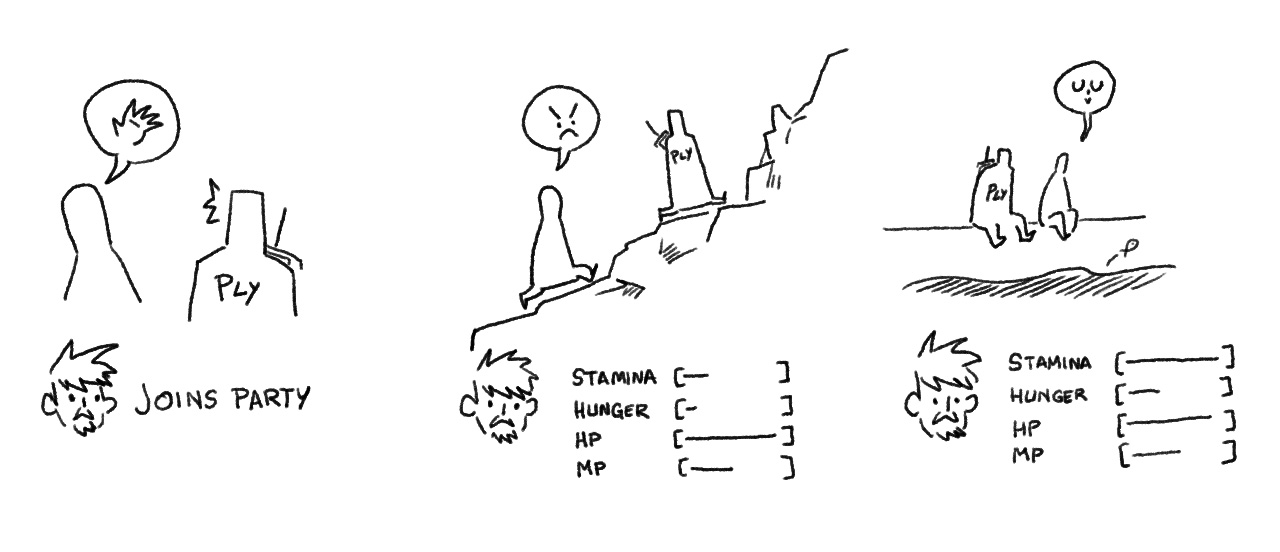
AI party members would provide abstract responses to stimuli generated by gameplay or story content, which would give players the tools to build a cohesive narrative in their head. Even with simplified reactions, it's very easy to misiterpret player intent and reach broken states ("character A is now always angry at me and I have no idea why"), so it's probably safer to make these reactions immediate and consumable, rather than persistent throughout the game.
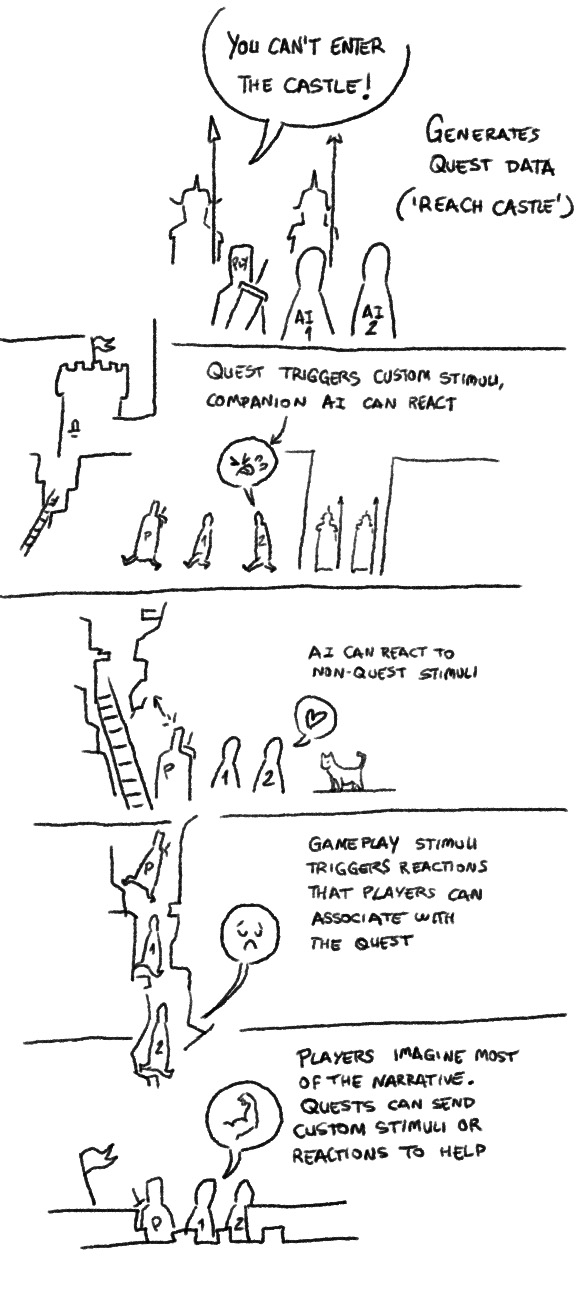
Content could then be divided into very few mandatory story beats with authored dialogue or even cutscenes; and recommended or optional content with bits of explicit story elements at their beginning / end (the only choke points we can ensure will exist, though we may find more oportunities to trigger more), along with supplementary, stimuli-triggered, abstracted AI dialogue.
| mandatory | recommended | optional | if you want, sure |
|---|---|---|---|
| Prologue (present into past) | |||
| Meet Mint (clerk) | |||
| Meet Arche (mage) | |||
| Meet Undine (spirit) | |||
| Find Efreet (spirit) | |||
| Find Gnome (spirit) | |||
| Find every other spirit | |||
| Find Origin (spirit) | |||
| Explore map, do non-spirit quests | |||
| War politics, mana cannon | |||
| Assault on Dhaos (adds Klauss and Arche to party if not met) | |||
| Heal Mana tree (unicorn) | |||
| Find underwater city, travel to present | |||
| (find Undine and Efreet if you hadn't) | |||
| Find Maxwell (spirit) | |||
| Find Pluto (spirit) | |||
| Meet Origin | |||
| Explore present map, do quests | |||
| Assault on Dhaos (reprise) |
Since most of the story is crafted through players' gameplay, it'd be not so much consumed as it'd be created. On the one hand this could help alleviate the completionist feeling of "having to consume all content" which some players face, since they'd instead be able to drive their own story. On the other, this very lack of authored pace could drive users away.
# the game
# intro (cinematic)
- 100yo warriors defeat Dhaos, confine it using time-lock spell
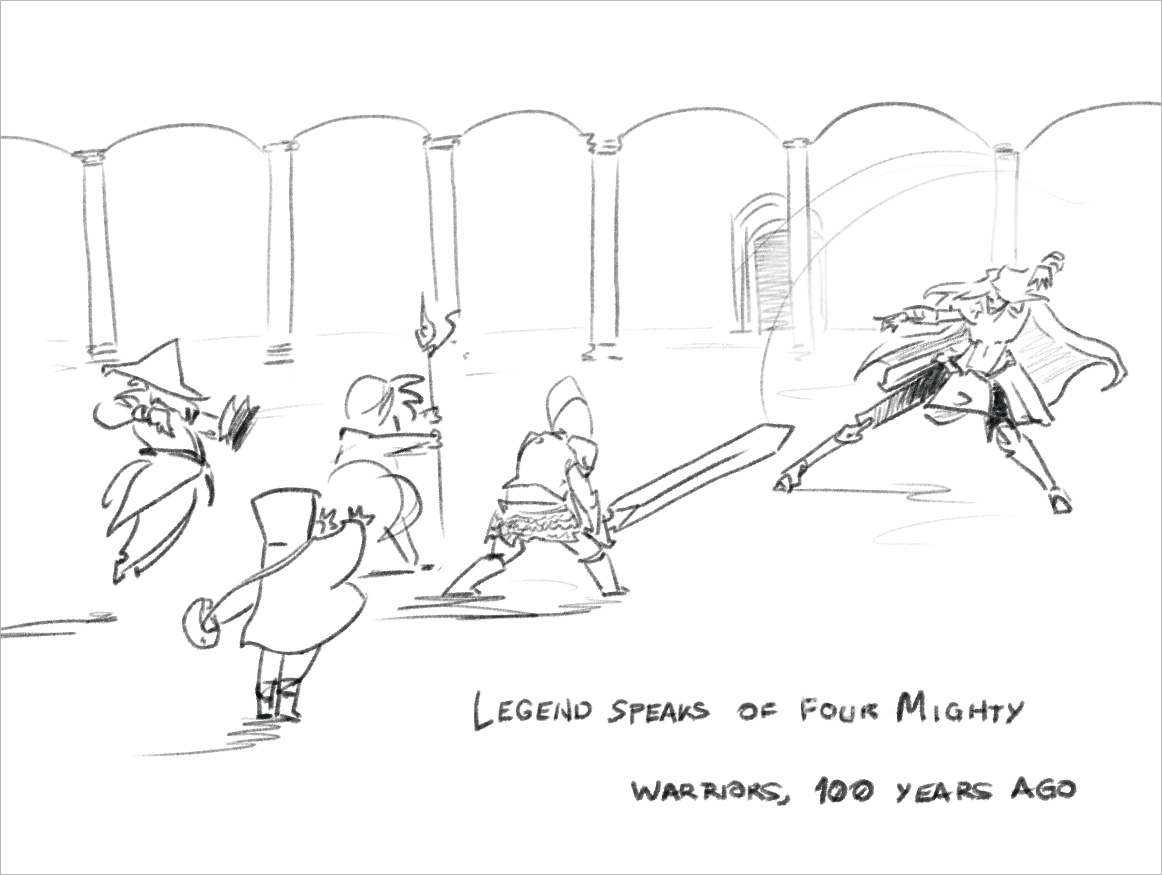
# prologue: present (gameplay, linear)
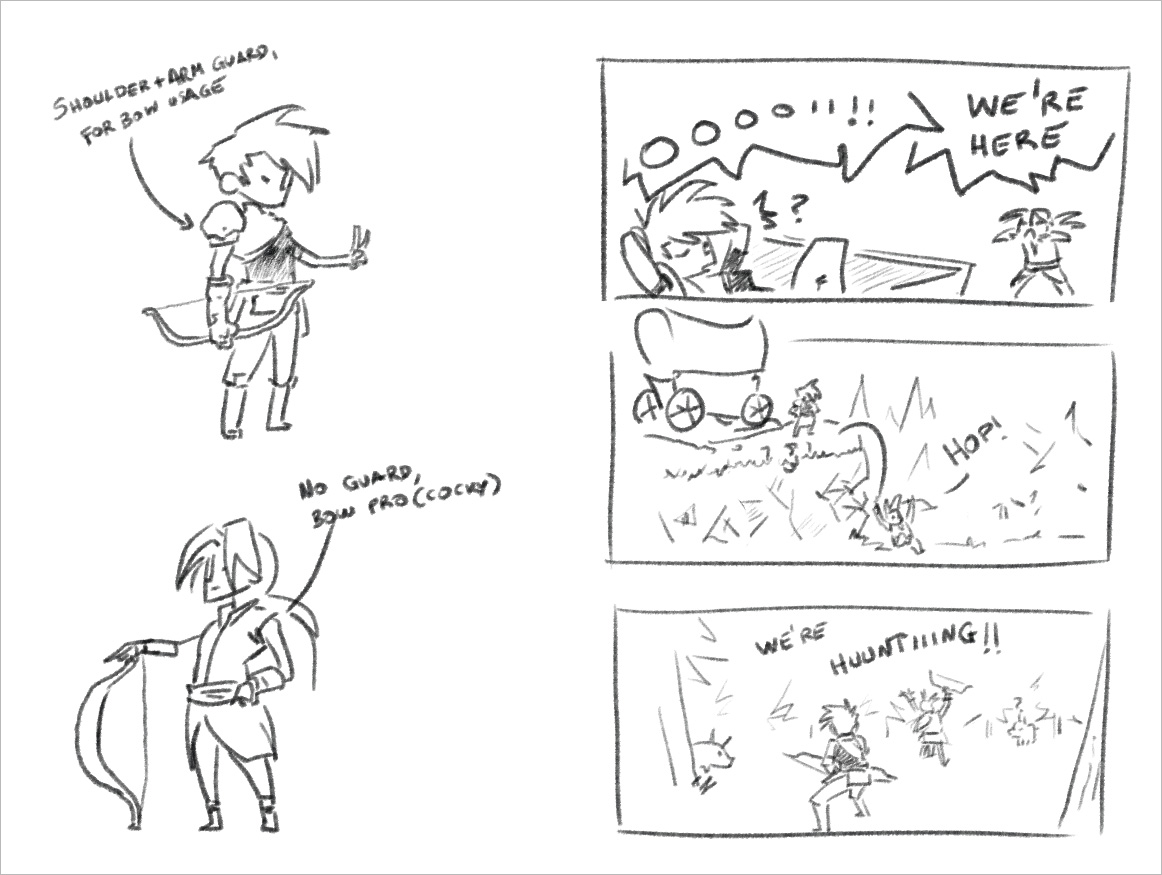
player goes hunting with archer AI partner in a confined area
earthquake, boars run away, one of them ventures into uncovered mausoleum
party splits at mausoleum, player explores
cult members appear as enemies, can capture player if defeated
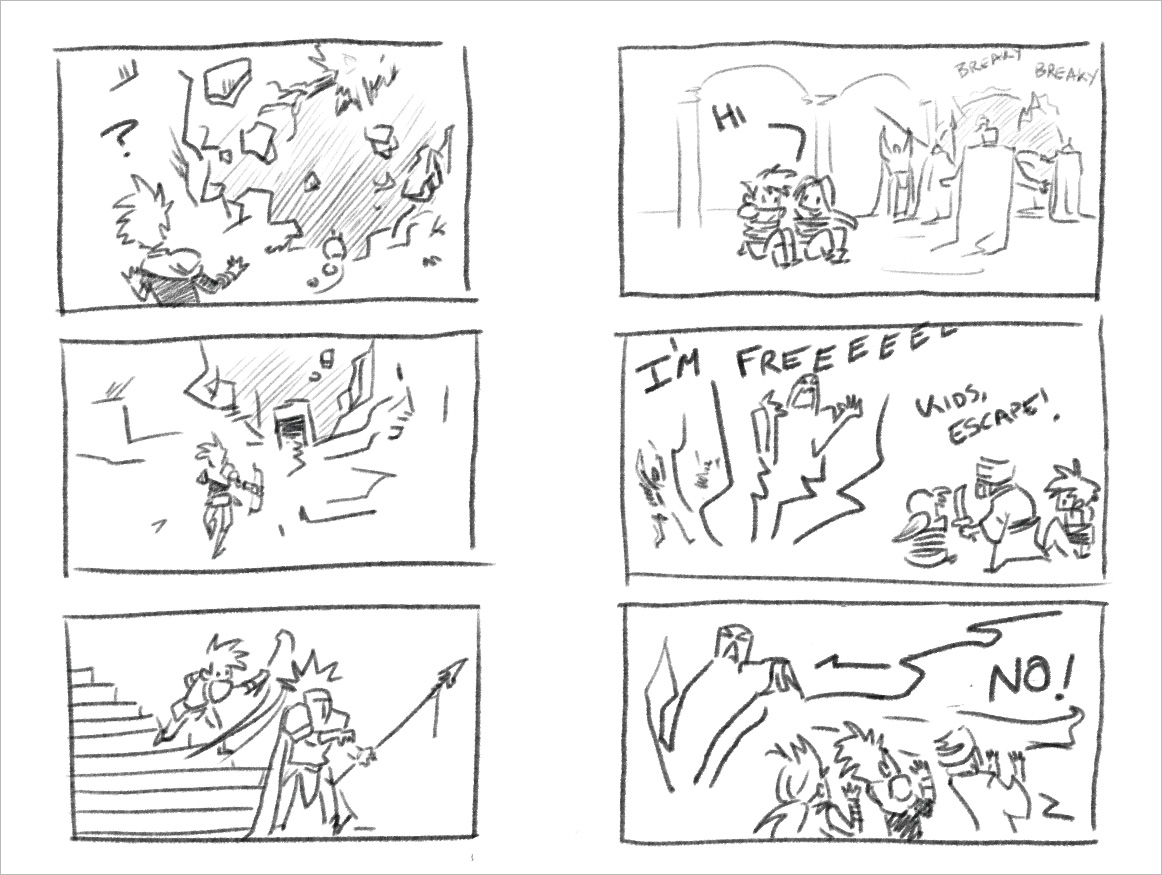
either by exploration or defeated, player reaches main chamber and reunites with captured AI partner
cult members have been there for weeks now, attempting to stop time-lock spell
sorcerer, who had been tracking down cult members and is finally able to enter mausoleum, frees party
time-lock spell starts breaking, Dhaos comes out, kills cult members
party fights Dhaos, unsuccessfully
sorcerer redirects time-lock energy to send party back in time and seek help from warriors who defeated Dhaos
player is given the name Klauss to look for (one of these warriors)
AI archer and sorcerer are knocked away from time-lock by Dhaos, only player travels back
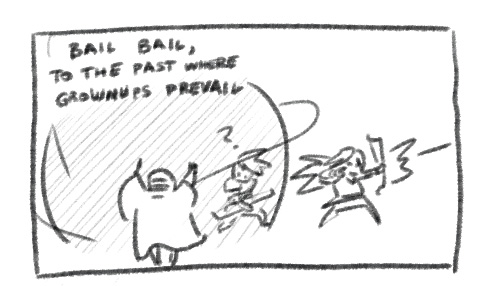
# start of main game (past): Mountain of Landing
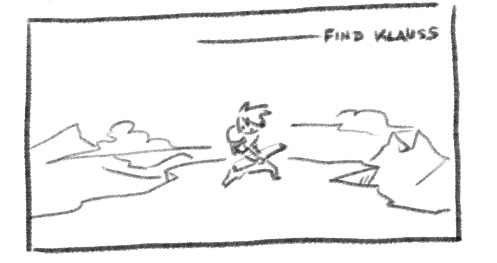
player appears on a mountain top, within sight of nearby town, only objective is to find Klauss
on the way down the mountain, either towards the town or not, player finds AI clerk (his placement is procedural to ensure player meets him)
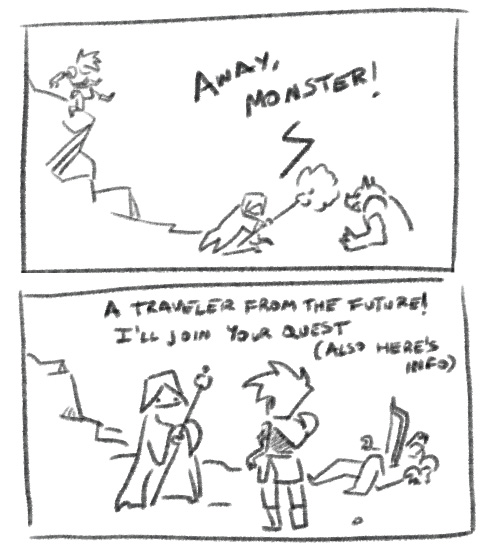
Clerk was at the magic mountain seeking a way to defeat Dhaos and avenge his family
Clerk joins party, provides exact location of Dhaos, plus general idea of where Klauss could be
# Dhaos
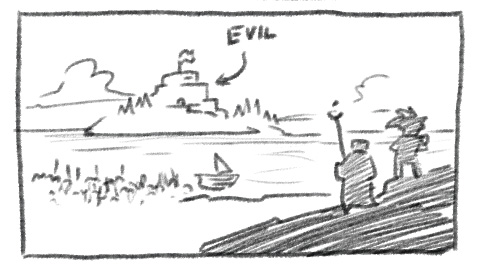
hides in an island, inside the past-version of the prologue's mausoleum
human army at the other shore, thinking how best to attack, near past-version of player's town
water traversal is required (paddle boat along the shore, a spirit can be used, maybe underwater cave)
spirits are encouraged to defeat Dhaos
# Quests and Progress
map is divided into areas, the first x NPCs in each area provide map info
quests can be activated regardless of party members / spirit progress
add here quests from original game (find Edward, collect spirits, etc)
through them the player builds up the feeling of journeying
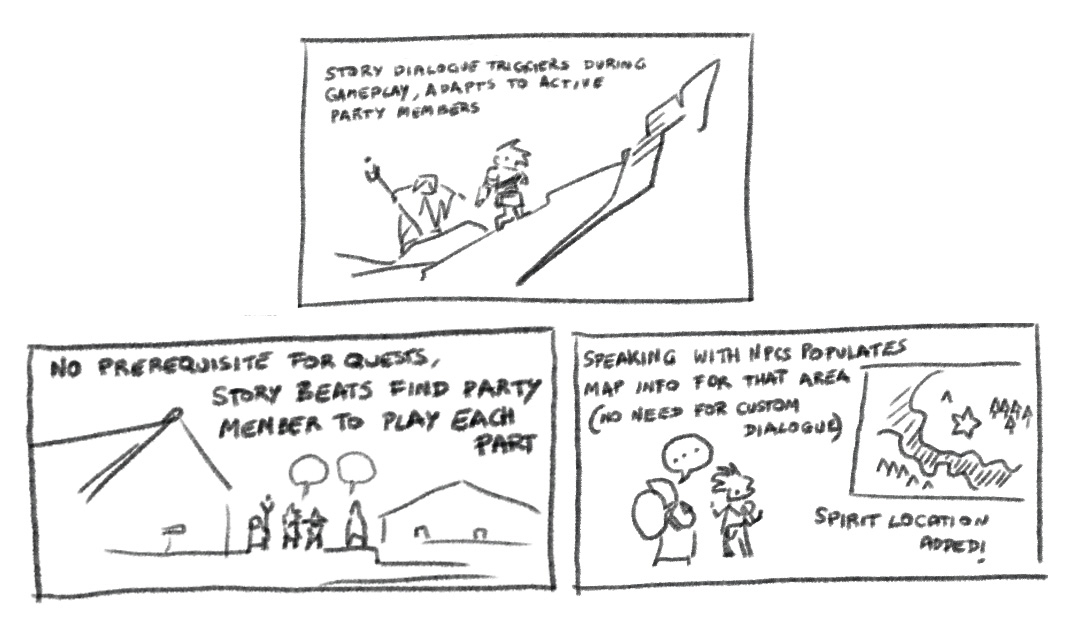
# Klauss
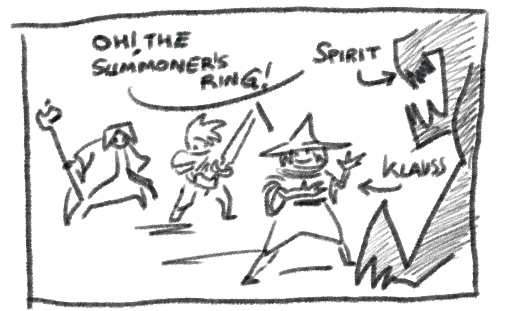
location given when approaching general area, can be found at her cabin
found as well inside any of the spirit lairs, attempting to form a pact
maybe found outside elf town?
Wherever you meet her, she sees player's summoning ring and joins party
general area of some spirits is given then
# Arche
same general area as Klauss, location is given when visiting main town there
joins party after finding and helping him
# Spirits
found in (almost?) each area
general location of main ones (Gnome, Undine, Efreet) given when meeting Klauss
others can be found by exploring areas of map
# Origin (spirit)
found inside elf town, Arche (half-elf) is forced to stay outside if present
hidden at the end of mysterious woods
repairs summoning ring to increase their power (only if enough spirits have been collected?)
# Attack on Dhaos
spirits help, alt ways possible
even if the player has not met AI party, they show up to offer some help
player party turns out to be the 100 yo warriors from opening cinematic
after the fight, Dhaos is time-locked and it's time to face it in the present
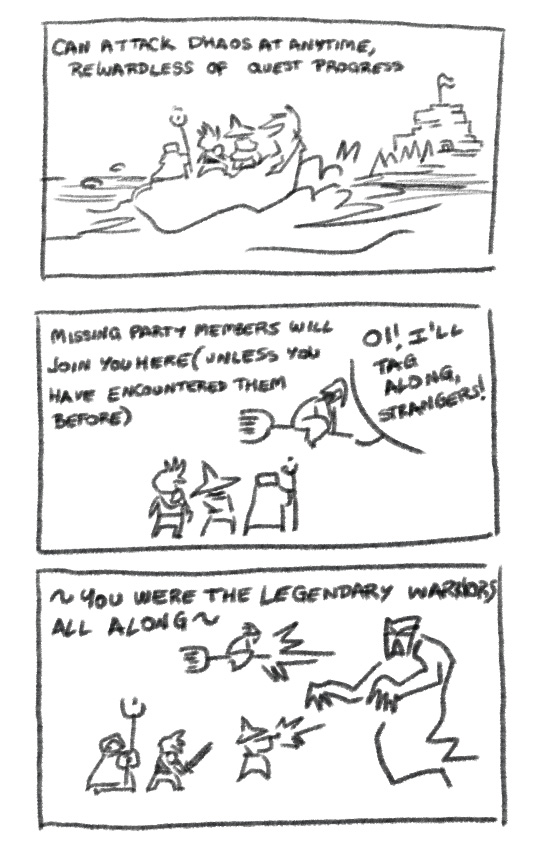
# Way back
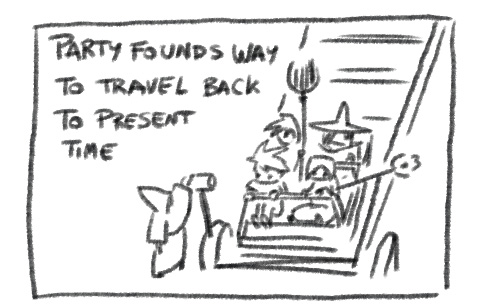
Find underwater city in order to travel back to present time
# main game (present): mausoleum
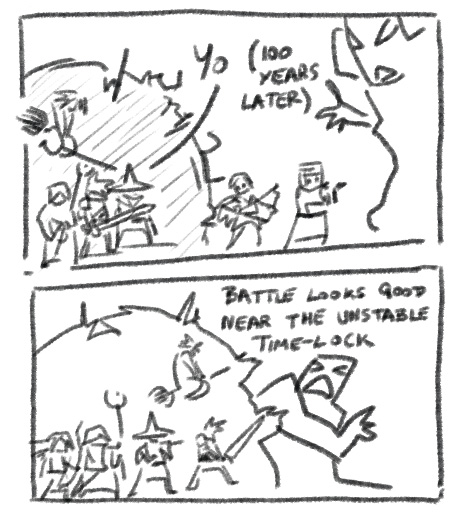
reunite with underleveled AI archer
fight Dhaos and get close to winning
time spell is unstable and party is projected 4 years into the future
# Mountain of Landing (reprise)
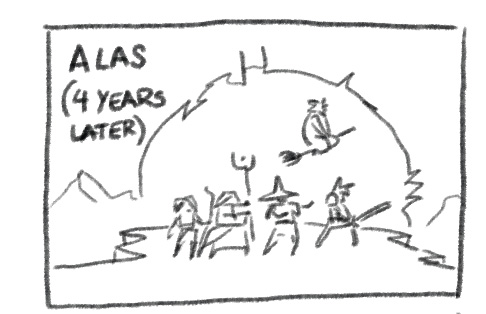
party lands here (either as friends or recent acquaintances depending on playthrough)
current objective is defeat Dhaos, who has broken havoc during these years
# Spirits
spirits from the past can be collected here if not picked before
additional spirits can be found
# Origin
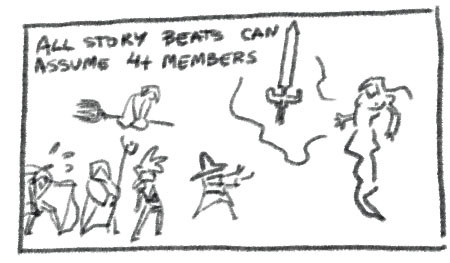
forges eternal weapons
# Cult's hideout
trap Dhaos (if no eternal weapons) or defeat it for good
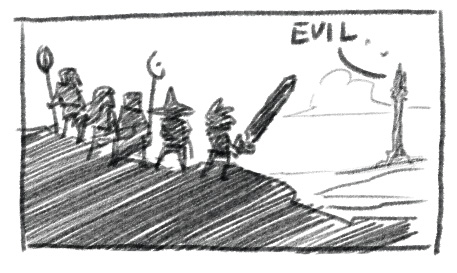
# art style
Several options:
1:1 scale 3D
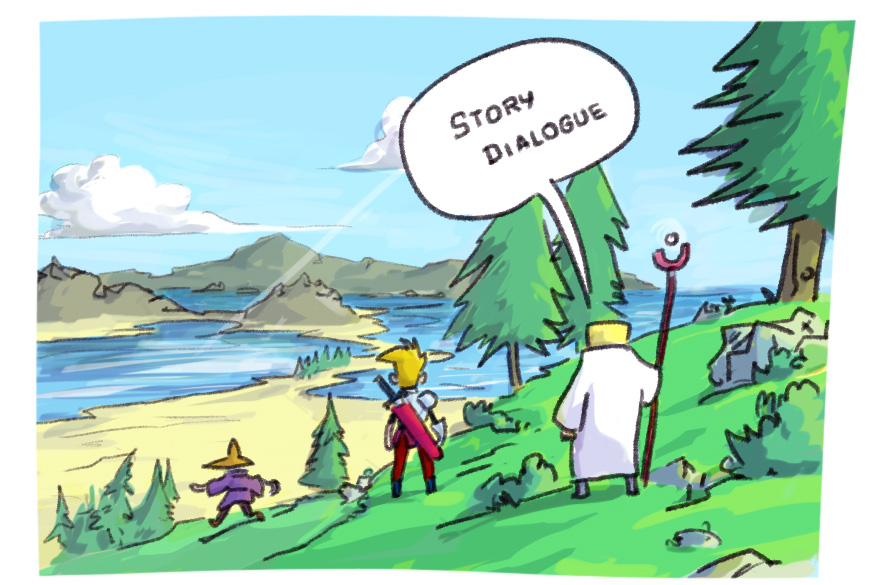
Easier for player to see into the distance, wayfinding is encouraged. Barely no abstractions. AI buddy behavior has been attempted many times in AAA games, and it can easily look bad. Extensive content creation required, very easy to break immersion with imperfections or inconsistencies. Examples: FFXV, Breath of the Wild.
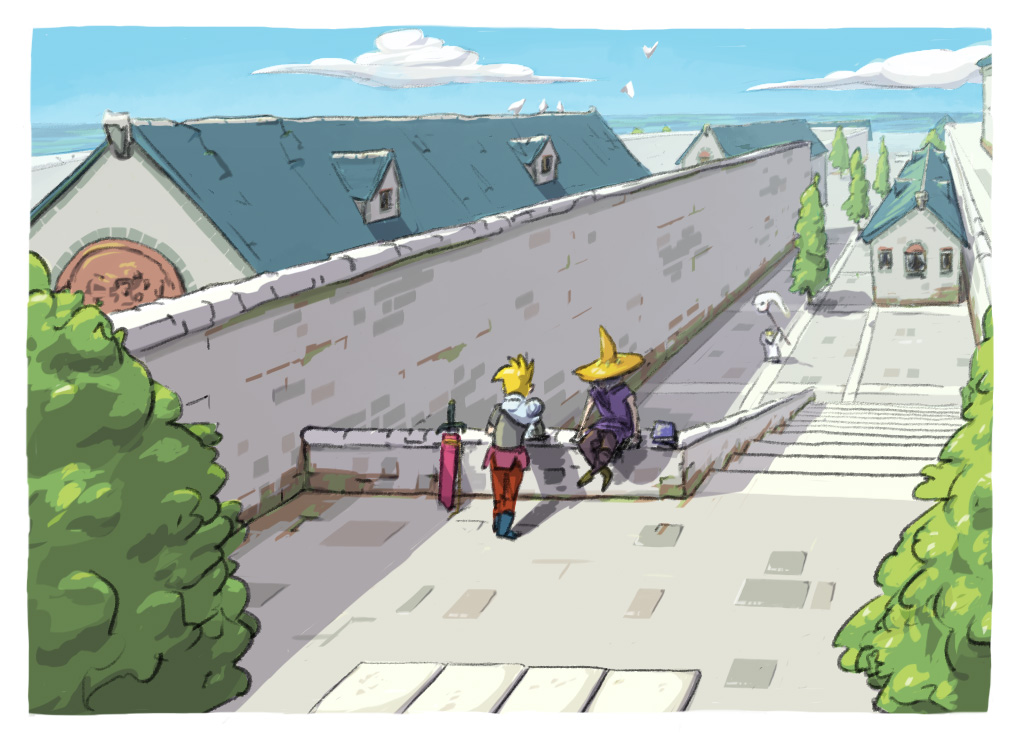
PSX-era abstracted 3D
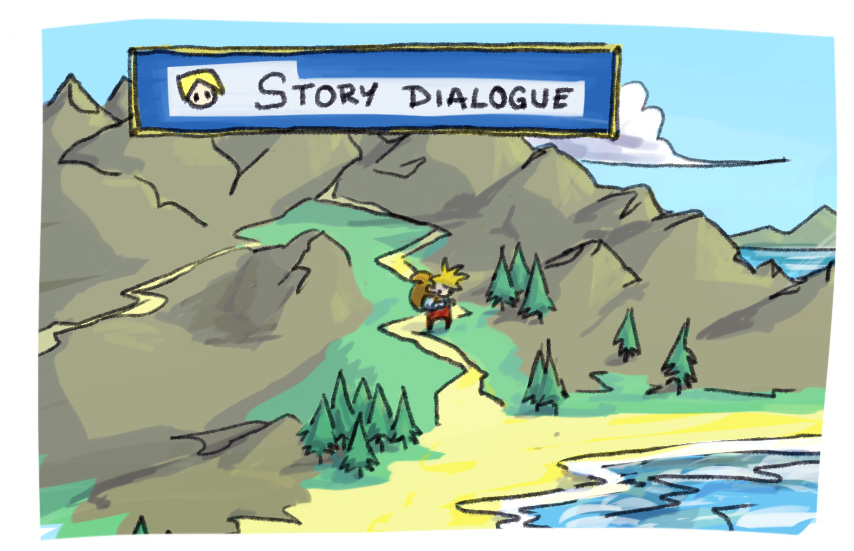
Abstracts content, "easier" to develop. Can be combined with style A for specific points of interest, or maybe through explicit player input (would require procedurally-generated detailed view?). Exploration elements need to be clearer in the abstracted world. Dialogue triggering and gameplay elements can cheat.
SNES-era top down map, close-up inside POIs
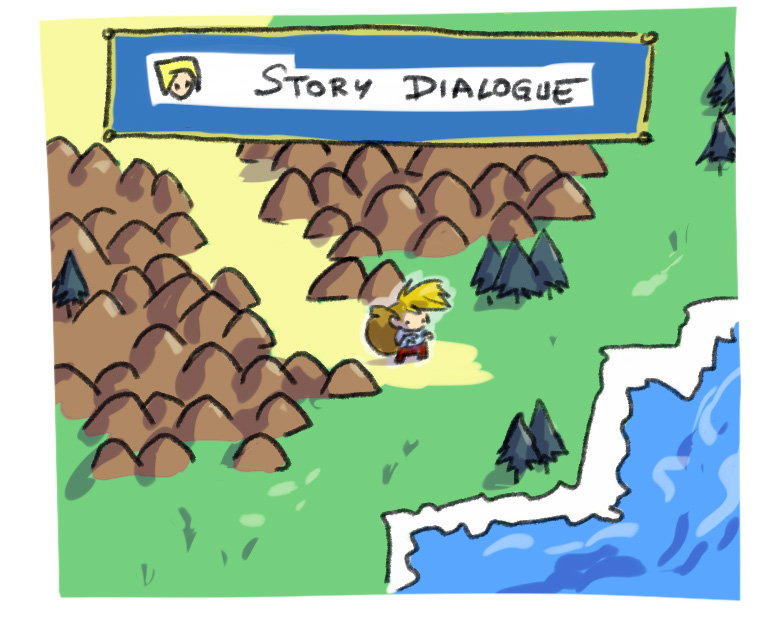
Different style of exploration, it's no longer possible to place points of interest in the distance to incite interest. Easier to develop. Once the player understands the language, it's harder to break immersion as long as elements stay consistent with the abstractions they represent.
Similar to styles A+B, close-up view can be triggered at Points of Interest or through player controls.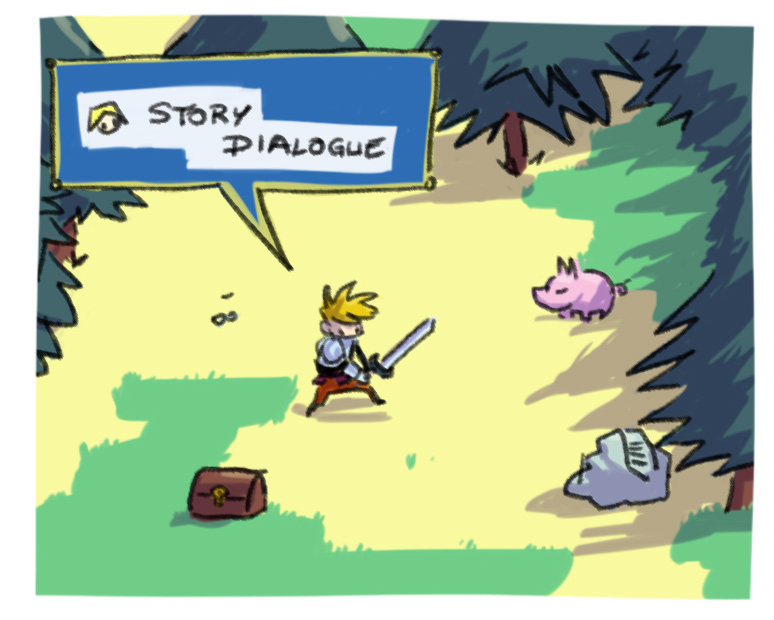
Black and white contour rendering
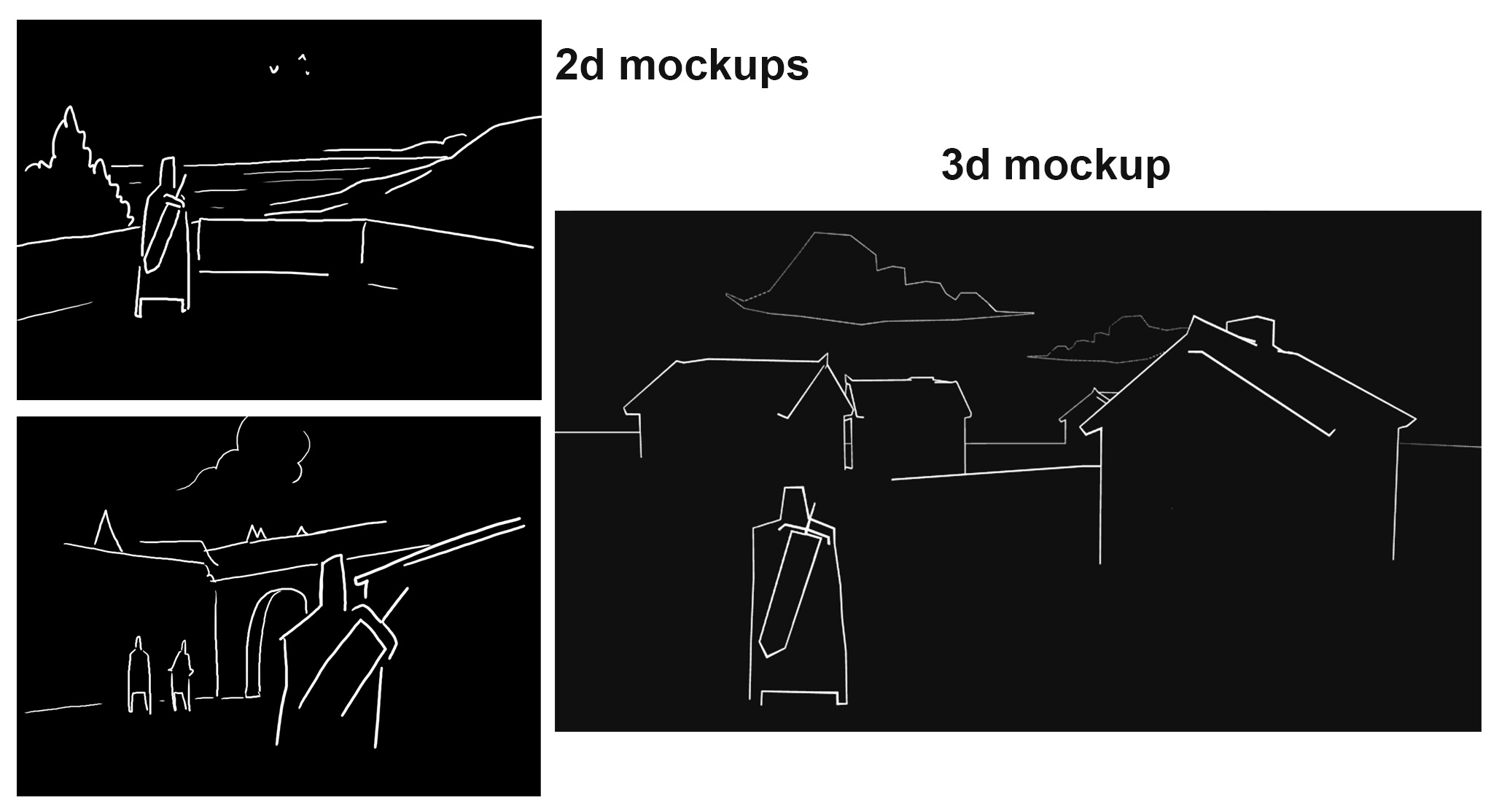
Can retain wayfinding benefits of style A, while still abstracting content and reducing the asset production efforts. It'd likely require a good amount of investigation and iteration to find the right combination of style vs playability, since visibility and clarity are not immediate with this style. There may not be as much literature available to help solve issues.